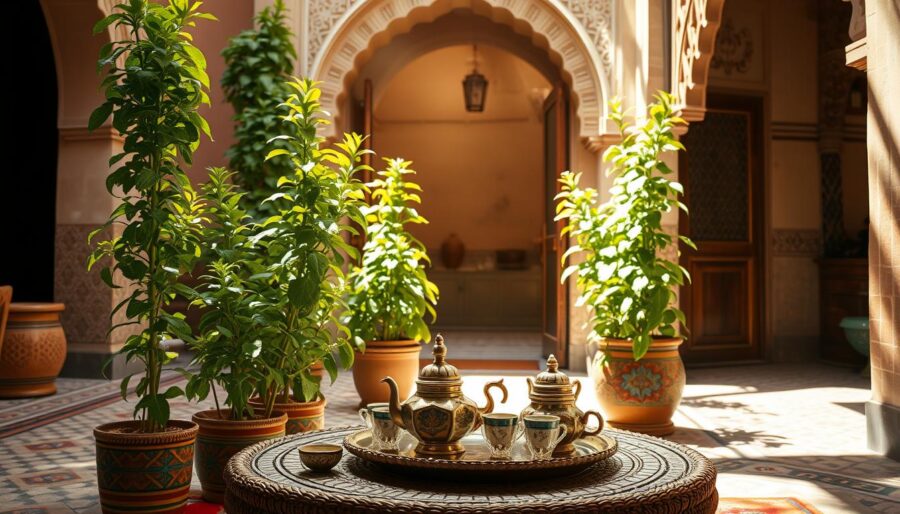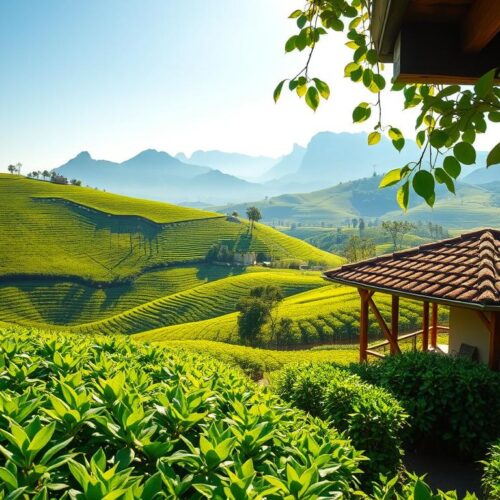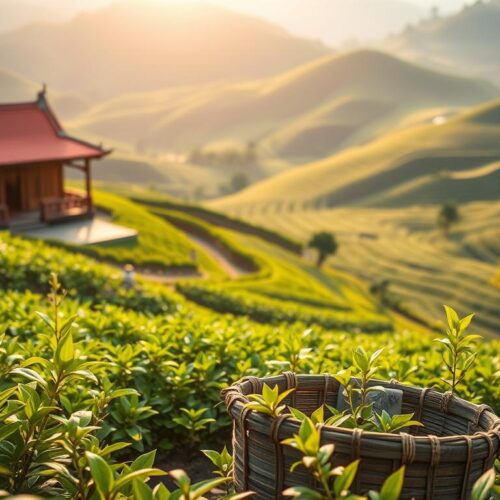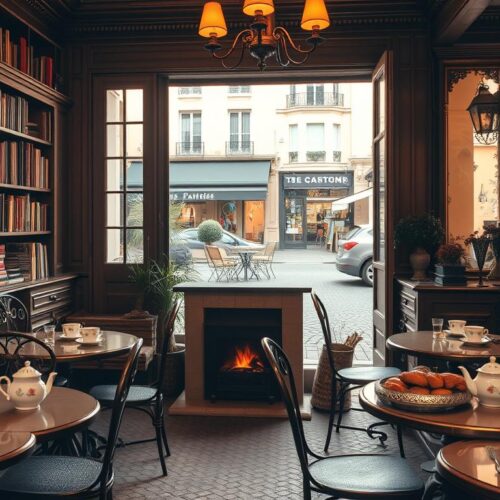As you step into the medina, someone offers you Moroccan mint tea. It’s warm, sweet, and filled with fresh leaves. In Marrakech, this welcome is more than just a habit—it’s a sign of Moroccan hospitality and an introduction to everyday life.
Vendors near Jemaa el-Fna stop to pour the tea from up high, creating a gentle foam. This action connects shopkeepers, guides, and visitors in a shared ritual. In the market, benches and kettles shared among vendors reflect a deeper tradition of trust and working together.
When you accept a glass of tea, you become part of the community. An Amazigh host may explain that refusing is considered rude. This tradition stems from religious and community values. Here, offering Moroccan mint tea is an act of hospitality, without any pressure to buy something.
The tea’s recipe is straightforward but meaningful: Chinese gunpowder green tea, fresh mint, and sugar. The process includes rinsing the leaves and pouring from high above to mix the tea well. The tea is both warm and cool, sweet and fresh—a perfect reflection of the city.
As you explore, you’ll notice that Maghrebi tea is part of many local practices. It concludes deals, makes negotiations smoother, and offers a break during busy days. The ritual invites you to take your time, share a moment, and truly see the people around you. This way, the tea culture of Marrakech helps you connect with the heart of the city.
Why Mint Tea Matters in Marrakech’s Medina
The moment a silver pot is brought out, you start to understand Marrakech’s tea culture. In the medina, a cup of tea is more than just a drink; it’s a welcome into the community. When you accept it, you’re embracing the local tradition of hospitality. This tradition values the relationship between guest and host greatly. Saying no might seem unfriendly, so it’s best to just take a sip and enjoy.
The tea ritual involves rinsing, brewing, and pouring in a special manner. Usually, men taste the tea first. Then, they pour it from high up to mix in the air and cool it down. The foam on top proves their careful technique. With every pour, there’s a hidden meaning; life’s bitterness, love’s sweetness, and the calm of the end.
As you walk through the market, you’ll get many tea invitations. It’s a way to sit down, join in, and pick up the local manners silently. An Amazigh (Berber) might tell you, tea here isn’t just about selling something. It’s about feeling you belong. Even in a busy market, sharing tea builds a bond of trust.
This practice is deeply rooted in faith. Islam encourages serving guests as if you’re serving God. You can feel this belief in the peaceful moment before tea is poured. The tradition of Sufism also supports this idea, emphasizing care in preparation and serving. This way, every cup of tea in the medina is a small act of faith and kindness.
Tea is a part of everything here, from work meetings to family dinners. It makes strangers become friends, one cup at a time. The way the tea is poured shows skill and respect. This shared understanding is key to the tea culture in Marrakech. It helps maintain the etiquette of the market and keeps the city’s heart warm.
Origins and Legends: How Moroccan Mint Tea Arrived
There are many stories about how Moroccan mint tea came to be, but two are most famous. The story of a royal gift stands out: Queen Anne Moulay Ismail’s exchange in the 17th century brought tea to the sultan’s court. This introduced the unique taste of the tea from the palace to the people, influencing culture and preferences.
Another story is about trading. In the 19th century, the British East India Company brought tea to Morocco’s ports like Essaouira. Green tea arrived via trade, mixed with local mint and sweetened with sugar. This mix became a favorite among merchants, workers, and locals alike.
There were hints of tea earlier, but it became a regular drink in the 19th century. Scholars say tea drinking grew then, even if travelers thought it was an ancient tradition. This blend of myth and history is typical of Maghrebi tea lore, mixing fact and legend.
- Royal channel: gifts and diplomacy linked to Queen Anne Moulay Ismail shaped court taste.
- Maritime channel: British merchants used Essaouira to move tea along Atlantic and Mediterranean trade routes.
- Local craft: mint, sugar, and green tea adapted to climate and hospitality, refining the pour and aroma.
| Timeline | Vector | Key Actors | What Reached Morocco | Impact on Maghrebi tea history |
|---|---|---|---|---|
| 17th century | Diplomatic gifting | Queen Anne and Sultan Moulay Ismail | Fine teas presented at court | Elite adoption sets fashion and etiquette |
| 18th century | Merchant exchange | British traders and Moroccan brokers | Green tea shipments via Atlantic | Urban availability expands, taste spreads inland |
| 19th century | Port distribution | British East India Company Essaouira and local guilds | Regular consignments of China green tea | Mass consumption anchors Moroccan mint tea origins in daily life |
When you look at these stories, a fascinating journey of Moroccan mint tea unfolds. It came through royal gifts, trading, and local traditions. All these elements kept the love for Moroccan mint tea brewing over centuries.
The Tea Ritual: From Rinsing Leaves to the “Turban” Foam
The tea ritual is like a dance. Men often lead, showing respect and welcoming guests. It starts with gunpowder green tea, known for its strong flavor and rolled leaves.
The first step is to quickly pour boiling water over the leaves. This makes them softer and ready for brewing. Then, fresh spearmint and sugar are added. Finally, hot water is poured in to avoid overheating the tea.
The host mixes the tea by swirling the pot or moving some to a glass and back. This mixes everything well. Then, they let the tea steep and adjust the flavor to get the perfect balance.
Next is the high pour, which cools the tea and brings out its smell. When done right, it creates a foam on top, showing the maker’s skill and care.
You receive the tea in a series, aligning with a local saying. Each cup tastes different, moving from sharp to sweet to soothing, all from one batch of leaves.
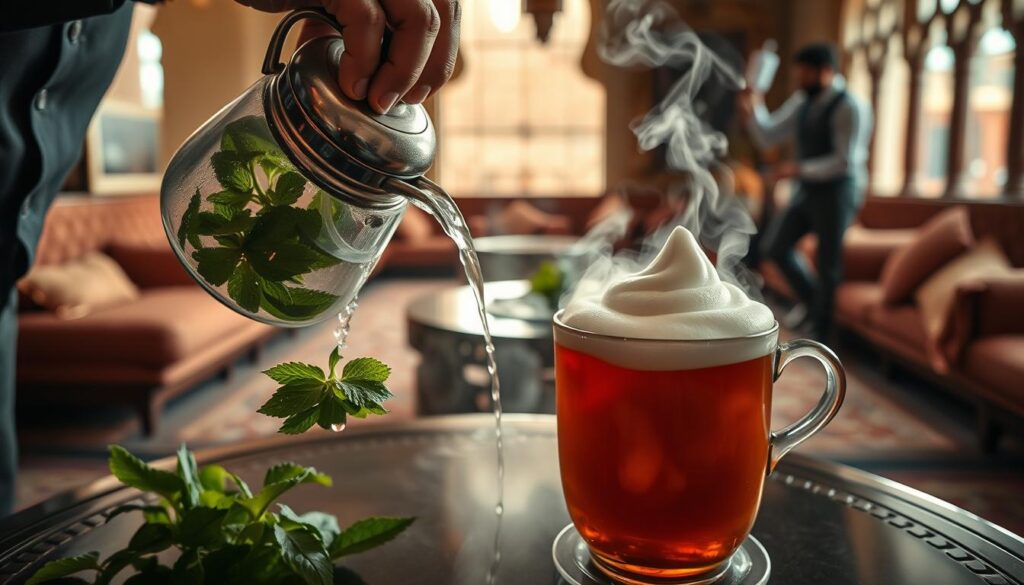
| Step | What You Do | Why It Matters | Sensory Cue |
|---|---|---|---|
| Rinse and Aerate | Flash-wash gunpowder green tea with boiling water | Reduces bitterness and wakes the leaves | Leaves unfurl; aroma turns bright |
| Add Mint & Sugar | Layer fresh mint and generous sugar into the pot | Builds balance between herb, sweetness, and tannin | Cool menthol lifts the steam |
| Controlled Steep | Pour hot water; avoid a rolling boil | Protects flavor from over-extraction | Liquor glows light amber |
| Blend Without Spoon | Swirl or pour glass-to-pot repeatedly | Integrates sugar and mint evenly | Texture feels round, not sharp |
| High Pour | Pour from above into small glasses | Oxygenates, cools, and forms turban foam | Soft foam cap crowns each glass |
| Three Pours Proverb | Serve three rounds before changing leaves | Honors tradition and shared hospitality | Flavor evolves with each pour |
Marrakech tea culture
The heart of Marrakech tea culture greets you upon arrival. A tray is often brought out in various places. Whether it’s in a riad lobby, a shop doorway, or on a rooftop, accepting it means you belong. The offering of three small glasses, served from a height, warmly welcomes you. It turns a simple visit into a moment of connection.
In the medina, offering mint tea is a common act of hospitality. It’s offered when you check in, during your market visits, and before trips to the Atlas Mountains. Accepting it is a way of respecting guest rights. It also makes navigating through the crowded streets easier.
Getting the tea balance right is important to hosts. They mix fresh nana mint, green tea, and sugar to taste. Pouring the tea carefully adds air and creates a frothy top. This method reflects their community values. It shows that making tea is an act of care where every glass is meaningful.
An Amazigh guide might tell you that it’s rude to refuse tea. The offer is about welcoming you, not pushing sales. Tea represents a bond, inspired by Sufi beliefs, between God, the guest, and the host. This makes the act of drinking tea a mix of duty, joy, and trust.
Neighborhood acts of kindness, like borrowing tools and helping travelers, are common. These actions are similar to the hospitality you experience with each cup of tea. The tea culture in Marrakech creates connections from simple moments. Life in the medina becomes richer when you stop to enjoy tea and extend your stay.
- By accepting the first glass of tea, you honor your role as a guest and build connections.
- Sharing kettles and tea-time with families shows the strong community values here.
- When hosts serve you patiently and with grace, you get a glimpse into Sufi ethics.
In places from La Mamounia to family stalls near Jemaa el-Fnaa, “atay bi nana” mixes business with relaxation. Drinking this tea, you feel welcomed. You get to know the city’s pace and culture through the steam and scent of mint.
Where to Sip: Tea Rooms, Souks, and Riads
Start at a classic tea room in Marrakech. You can see the high pour and admire the teapot’s shine. Pair your tea with sweet treats like gazelle horns or flaky baklava. At Pâtisserie des Princes, near Jemaa el-Fna, pastries cost about €20 per kilo. You might want to bring a box for takeout.
In the souk, being offered tea means you’re trusted. You’ll witness the making process, from rinse to the final pour. At a quiet riad, mint tea welcomes guests, offering a break from the bustling streets.
Day trips to the Atlas Mountains present a scenic tea-drinking setting. Amazigh hosts share their tea ceremony, blending homeliness with formality. The ritual of warming the pot and the high pour brings a light foam to your tea. This special ceremony is also found in Marrakech’s glowing courtyards.
Pay attention to tea drinking customs. Always let the host pour for you. Holding the glass near its rim lets you feel its warmth. A second cup often comes with another pastry. But a savory snack could better match the tea’s sweetness. No matter where you are in Marrakech, this ritual connects every experience.
Taste Across the Maghreb: Variations You’ll Encounter
In the Maghreb, you find a common base: green tea mixed with mint and sugar, served with a lively foam on top. The way it’s made—rinse, steep, taste, and adjust—stays the same, but the tea itself changes. It changes flavor, feel, and sweetness based on where you are and who you’re with, all without losing its welcoming spirit.
In Tunisia, tea might come with pine nuts from the region on top. These nuts cool down the tea a bit and add a warm, toasty flavor. Some hosts might add a mint leaf to your glass, while others prefer to keep the mint in the pot. This way, they can make sure the tea has just the right strength.
If you go southeast, you’ll discover Taliouine saffron tea, distinguished by its strands of saffron. These strands are added early to give the tea color and a special scent. The saffron smooths out the tea’s flavor, ending with a light honey taste. After a quick sip, the host will adjust the sweetness to perfection.
In mountain villages, tea tells you where you are through the use of Amazigh herbs. You might taste wild thyme, wormwood, or verbena, which add a fresh, sharp flavor. The choice of herbs depends on the season and how high you are in the mountains. This makes a familiar drink taste unique and specific to the place.
Tea in desert camps signifies a time for rest and togetherness. As tea is poured three times, each glass is stronger and sweeter than the last. You’ll notice the beauty in the pouring, the foam’s glimmer, and the perfect mix of mint and sugar.
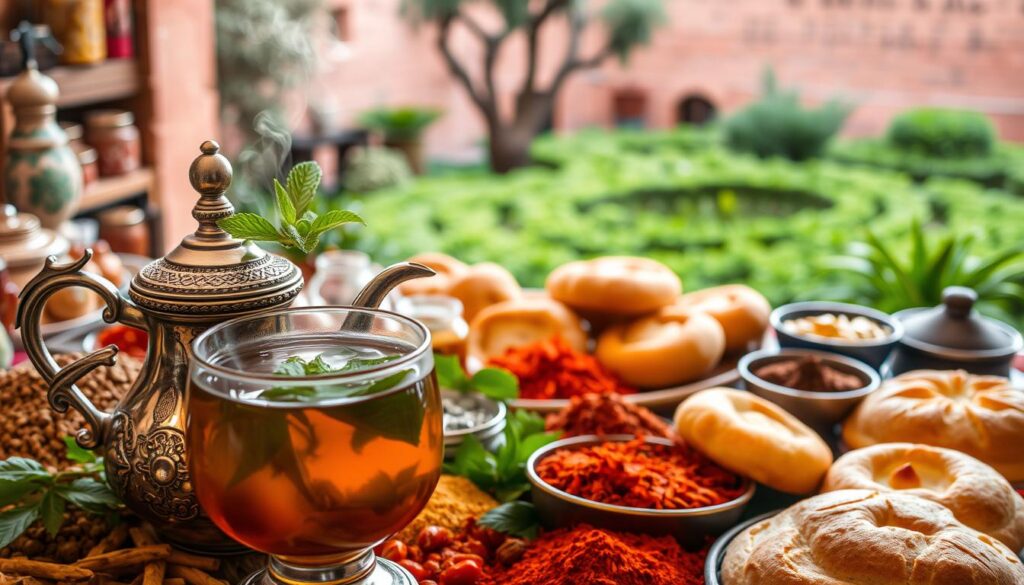
All over Morocco, Algeria, Tunisia, Libya, and Mauritania, the tea tradition is consistent, but every home has its unique twist. This shows how Maghreb tea keeps its foundational elements but can also reflect the landscape and memories it comes from. This ranges from Tunisia’s pine nuts to Taliouine’s saffron tea, from Amazigh herbs to the communal moment of Sahara tea.
Health Notes: Benefits, Sugar, and Sensitivities
In Marrakech, you’ll get mint tea offers many times a day. This happens from Jemaa el-Fnaa to riad courtyards. The tea is appealing because it has antioxidants from green tea and L-theanine. These help with cell defense and keeping focus, even with a bit of caffeine.
Spearmint in the tea helps with digestion. After walking in the souk or eating a heavy tagine, it makes you feel refreshed. The steam and aroma settle your stomach.
Usually, they serve this tea sweet, with lots of sugar. If sugar worries you or you care about teeth health, you can ask for less sugar. Or, make it at home with honey or agave. Remember to brush well and rinse at the right time if you drink it all day.
When you’re traveling, it’s easy to lose track of how much tea you’re drinking. Watch out for caffeine sensitivity, especially if you visit many cafés in Marrakech, Essaouira, or the Atlas Mountains. Try to have your last cup early to help your sleep.
Some might get heartburn from the tea. This is because hot liquid, mint, and tea tannins can make reflux worse in some people.
Tea tannins can also make it hard for your body to take in iron. If you have trouble with iron, don’t drink tea too close to eating iron-rich foods or taking supplements.
- Benefits: antioxidants green tea, digestive aid mint, fresh breath, focus from L-theanine.
- Watch-outs: caffeine sensitivity, sugar and dental health, GERD considerations, iron absorption timing.
- Simple tweaks: ask for less sugar, choose earlier cups, pair with water, and mind dental care.
Make It at Home: An Authentic Moroccan Mint Tea Method
Creating Moroccan mint tea involves simple steps and a bit of flair. Start by adding 2 spoonfuls of gunpowder green tea to a teapot. Next, rinse the leaves with boiling water and swirl. This removes the bitter flavors without losing the tea’s scent.
Add lots of fresh spearmint and your choice of sugar cubes, honey, or agave. Then, pour in hot water that’s just off the boil. This prevents the tea from being overcooked. Let it steep for 5 minutes. This helps mint oils to release and sugar to melt.
For mixing, there’s a classic trick: pour half a glass of tea and then pour it back. Repeat this a few times; no spoon is needed. After tasting, you can adjust the mint or sweetness. This approach ensures the tea stays flavorful, just like in Marrakech.
The pour is part of the show. Start pouring from high above into small cups to add air, cool it slightly, and create a foamy top. This elegant gesture shows you care about your guests. It turns serving tea into a special event.
Serve it right away while it’s hot and fragrant, with extra mint on the side. This captures the essence of Moroccan mint tea: clean and brisk with a minty, sweet lift. It’s about sharing a lovingly prepared drink with others.
Conclusion
You came to learn about mint tea in Marrakech. You discovered the ritual: rinse the leaves, brew with fresh mint, sweeten to taste, then pour from high to create a “turban” of foam. Each cup shares Moroccan hospitality and the Maghrebi tea legacy. In the medina, the craft shines near Jemaa el-Fna, with trays of sweets and welcoming steam.
Exploring souks and riads or visiting Amazigh homes, you feel the bond tea creates between host and guest. Accepting a cup ties you to local life and traditions. It changes your views on safety and trust. You find yourself in a place where kindness is key and talks take their time. You realize Marrakech’s tea culture transforms a simple leaf into a link between people.
Atay bi Nanaa is both a daily drink and a special ceremony. It calms, but be mindful of sugar and caffeine. Drinking tea in Marrakech or making it at home connects you to a long tradition. It brings you into the heart of Moroccan hospitality.
Keep the flavors and memories with you. Recall the high pours, the three servings, and the peace that comes. Every sip blends the Maghrebi tea tradition with your own experiences. It invites you back to the soul of Marrakech’s tea culture and its timeless traditions.

